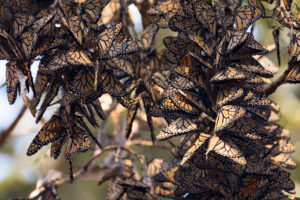
[Update, January 27: On January 25, the Xerces Society reported a final monarch count of 247,237, a more than 100-fold increase over 2020 and the largest number since 2016.]
Since 1997, volunteers organized by the conservation group Xerces Society have counted western monarchs over Thanksgiving at the butterflies’ overwintering sites around coastal California, as part of the Western Monarch Thanksgiving Count. In 2020, the count hit an all-time low — less than 2,000 monarchs; a number, Bay Nature reported last year, that “represents an astonishing continuation of the near-total collapse of the western migratory population of the species over the last few decades.” Scientists then weren’t certain if any of the butterflies would come back at all. The preliminary reports out of this year’s count, however, suggest that they did, and in a big way.
“We’re well over 100,000 butterflies at this point,” said Emma Pelton, the Xerces Society’s senior endangered species conservation biologist and western monarch lead.
Data from over 200 monitoring sites show significantly greater numbers than last year. For example, more than 10,000 monarchs were counted at overwintering sites in Pacific Grove, Pismo Beach, and Big Sur. Last year, those three sites had less than 300 butterflies total. Similar trends are being reported from sites in Santa Cruz, Ventura, and Los Angeles. “We definitely haven’t seen an increase of this magnitude before,” Pelton said. The final numbers from the count overall are expected to be reported sometime in January.
Though this rebound gives cause for hope for the struggling monarch population, it does beg the question: How did it happen?
“That’s the question of the day,” Pelton said. “I would love to know.”
There’s a couple of different theories, with some studies to back them up. One hypothesis is that this year’s boom is due to an influx of monarchs from the eastern migratory population — which typically migrates between Mexico and the United States and Canada east of the Rocky Mountains — joining western monarchs, thereby adding to the population. Another theory, based on a recent study, suggests that monarchs are spending winters breeding in backyards in the East Bay instead of sheltering as they’ve traditionally done, probably due to warmer weather. Pelton, however, said she doesn’t find these theories very compelling — especially the latter one. “I’m not totally sure why we would think brief winter breeding in a different area of the coast would lead to that increase,” she said. “We see a lot of that sort of behavior in Southern California and we have for decades. It has not helped the population.”
The more straightforward explanation of why there are more western monarchs this year is this: good luck.
“It’s a series of fortunate events,” said Cheryl Schultz, an entomologist at Washington State University.
Monarchs, explained Schultz, have an incredible capacity for reproduction. Like other insects, they can go from almost nothing to enormous numbers seemingly overnight — if the conditions are right. A single adult female can lay 300 eggs, which multiplies with each of the monarchs’ typically four of five breeding generations in a year. So, if it’s a good year, with good weather, monarchs can produce a lot of offspring. In a recent blog post about the “bounciness” of monarchs, Xerces Society researchers wrote that, like other insects, “monarchs are naturally ‘bouncy’ in that they fluctuate from year to year in response to the temperature, rainfall, the availability of food, and other factors.”
Smaller populations of insects can also be more vulnerable to variations in their surroundings such as bad weather — or good weather. In that way, the smaller the population, the more tendency there is for big swings in numbers (up or down) to take place from year to year. Smaller populations can experience reduced competition for resources, which can help increase their numbers under good conditions.

Ultimately, no one knows for sure why there’s an increase in western monarchs this year. The Xerces Society researchers conclude that the cause of the uptick can be a combination of any of the factors listed above, as well as others, such as the pandemic and human behavior, “changes in the timing and location of wildfires in the West, [and] changes in crop planting and pesticide use in the Central Valley due to drought.”
“We don’t have anything that we can point to with strong evidence for the uptick,” Pelton said. “It’s just they have the capacity to do this, and they did it. And we’re so lucky and so grateful that that happened.”
“Being at 100,000 just kind of gets us out of the absolutely critical danger zone. But we’re still in the danger zone. We’re still very far below historical norms and the population is still in trouble.”
Although scientists like Pelton and Schultz are delighted by the incoming results of this year’s count, they are also very cautious; they know that western monarchs are not out of the clear yet.
“It’s not recovery,” Schultz said.
When considering long-term trends, the 100,000 monarchs counted this year don’t come close to what the numbers were decades ago—or even just a couple of years ago. Millions of monarchs overwintered in California in the 1980s; hundreds of thousands from the 1990s through the 2000s. If 100,000 is indeed the final count for this year, that’s still only half of what the final count was in 2017. Researchers stress that we must not normalize a new baseline and forget all that has been lost.
“It’d be a very different story if we got a million monarchs this year,” Pelton said. “Being at 100,000 just kind of gets us out of the absolutely critical danger zone. But we’re still in the danger zone. We’re still very far below historical norms and the population is still in trouble.”
The U.S. Fish and Wildlife Service announced in December 2020 that after a four-year assessment it found the monarch butterfly qualifies for protection under the Endangered Species Act (ESA). However, the agency said other species had higher priority and that the monarchs would not receive any protection for the time being. They plan to review the decision again this year. Despite the boom in 2021, experts don’t believe the higher numbers will affect the butterfly’s ESA qualification. “A useful analogy may be the rain that many Californians are experiencing this fall after a prolonged dry spell,” the Xerces researchers wrote. “It’s more rain than expected, but it doesn’t refill all the reservoirs nor mean that the drought is over.”
“We’re too close to the bottom to feel comfortable,” Schultz said. “If anything, it buys us a little bit of time to do planning for long-term conservation efforts.”
Researchers say people can help support long-term conservation efforts for western monarchs and maintain this year’s upward momentum by protecting overwintering areas; enhancing habitat in breeding areas by planting native milkweed and flowers that provide nectar; reducing pesticide use; and contributing to community science by reporting and taking pictures of western monarchs and uploading them to apps like iNaturalist.
“The numbers are up; this is an amazing thing that we should be celebrating — but this isn’t recovery,” Pelton said. “If anything, hopefully it serves as fire underneath us to do even more and double down on helping the monarchs. We may not have good luck and good weather next year. And we haven’t really solved the root causes of why we got to these low numbers in the first place.”




